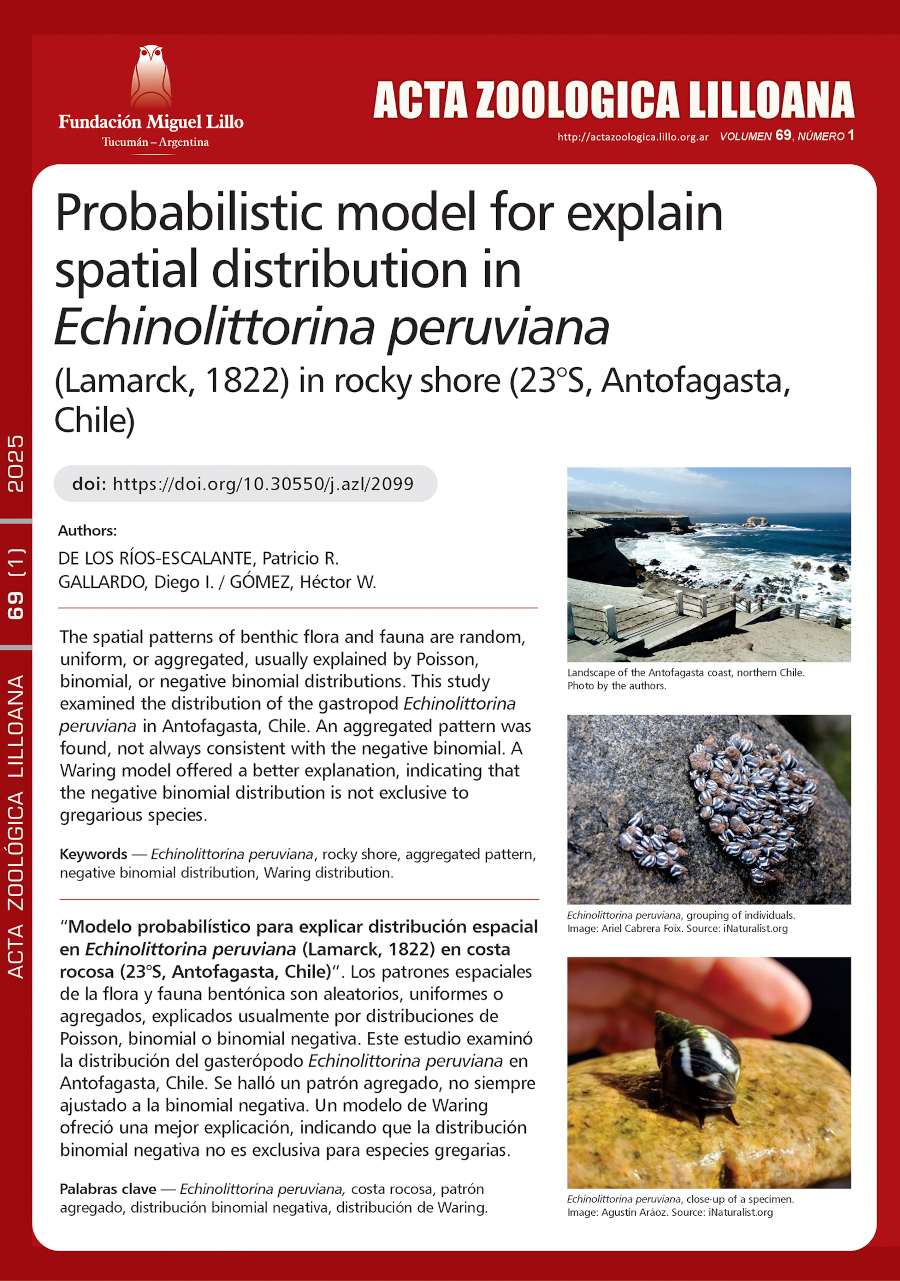Modelo probabilístico para explicar distribución espacial en Echinolittorina peruviana (Lamarck, 1822) en costa rocosa (23°S, Antofagasta, Chile)
DOI:
Keywords:
Echinolittorina peruviana, rocky shore, aggregated pattern, negative binomial distribution, Waring distributionAbstract
The spatial patterns in benthic flora and fauna have three patterns random, uniform and aggregated. Usually models to fit this are the Poisson, binomial or negative binomial distributions, respectively. However, for specific cases such models cannot be appropriated. The aim of the present study is analyse data of gastropod Echinolittorina peruviana (Lamarck, 1822) obtained in rocky shore of Antofagasta north of Chile, with the aim of determine a reasonable model for explain its spatial distribution. The results revealed that individuals have an aggregated pattern, but not all populations have negative binomial distribution, and it was proceeded to determine an alternative model to the negative binomial distributions family to explain the spatial distribution. The results revealed that population distribution can be adjusted to a Waring model. These results would agree with literature descriptions that negative binomial distribution is not the exclusive pattern that can explain the aggregated pattern in gregarious species.
Downloads
References
Aguilera, M.A., Navarrete, S.A. (2011). Distribution and activity patterns in an intertidal grazer assemblage: influence of temporal and spatial organization on interspecific associations. Marine Ecology Progress Series, 431: 119-136. DOI: https://doi.org/10.3354/meps09100
Aguilera, M.A., Navarrete, S.A. (2012). Interspecific competition for shelters in territorial and gregarious intertidal grazers: consequences for individual behaviour. PLoS One, 7: 1-30. DOI: https://doi.org/10.1371/journal.pone.0046205
Ahmad, O., Fang, T.P., Yahya, K. (2011). Distribution of intertidal organisms in the shores of Teluk Aling, Pulau Pinang Malaysia. Publications of the Seto Marine Biological Laboratory, 41: 51-61. DOI: https://doi.org/10.5134/159483
Brower, J.E., Zar, J.H., Von Ende, C.N. (1998). Field and laboratory methods for general ecology. 4th ed. Dubuque: WCB McGraw Hill
Castillo, V.M., Brown, D.I. (2010). Echinolittorina peruviana (Lamarck, 1822): antecedentes de la especie. Amici Molluscarum, 18: 39-42.
De Los Ríos, P. (2017). Non randomness in spatial distribution in two inland water species malacostracans. Journal of King Saud University, Sciences: 29: 260-262. DOI: https://doi.org/10.1016/j.jksus.2016.12.002
De Los Ríos Escalante, P., Carreño, E., (2020). Spatial distribution in marine invertebrates in rocky shore of Araucania region (38°S, Chile). Brazilian Journal of Biology, 80: 362-367. DOI: https://doi.org/10.1590/1519-6984.208863
De los Ríos-Escalante, P., Esse, C., Stella, C., Adikesavan, P., Zúñiga, O. (2023). Spatial distribution of Echinolitorina peruviana (Lamarck, 1882) for intertidal rocky shore in Antofagasta (23° S, Chile). Brazilian Journal of Biology, 83: e246889. DOI: https://doi.org/10.1590/1519-6984.246889
Elliot, J.M. (1977). Some methods for the statistical analysis of benthic invertebrates. Freshwater Biological Associations Scientific Publication.
Fernandes, M.G., Busoli, A.C., Barbosa, J.C. (2003). Distribucao espacial de Alabama argillacea (Hubner)(Lepidoptera: Noctuidae). Neotropical Entomology, 32: 107-115. DOI: https://doi.org/10.1590/S1519-566X2003000100016
Lee, M.R., Castilla, J.C., Fernández, M., Clarke, M., González, C., Hermosilla, C., Prado, L., Rozbacczylo, N., Valdovinos, C. (2008). Free-living benthic marine invertebrates in Chile. Revista Chilena de Historia Natural, 81: 51-67. DOI: https://doi.org/10.4067/S0716-078X2008000100005
Rigby, R.A., Stasinopoulos, D.M. (2005). Generalized additive models for location, scale and shape, (with discussion). Applied Statistics, 54, 507-554. DOI: https://doi.org/10.1111/j.1467-9876.2005.00510.x
Santelices, B. (1992). Algas marinas de Chile: distribución, ecología, utilización y diversidad. Santiago de Chile: Ediciones Pontificia Universidad Católica de Chile.
Tejada-Pérez, C.A., Villasante, F., Luque-Fernández, C., Tejada-Begazo, C.L. (2018). Mollusk richness and vertical distribution along the rocky shore of Islay, Arequipa, Southern Peru. Journal of Marine and Coastal Sciences, 10: 47-66. DOI: https://doi.org/10.15359/revmar10-1.4
Underwood, A.J., Chapman, M.G., (2005). Design and analysis in benthic surveys in environmental sampling. In: A. Eleftheriou and A. Mcintyre, eds. Methods for the study of marine benthos. (1-42). Oxford: Blackwell Science. DOI: https://doi.org/10.1002/9780470995129.ch1
Underwood, A.J. (2004). Landing on one’s foot: small-scale topographic features of habitat and the dispersion of juvenile intertidal gastropods. Marine Ecology Progress Series, 268: 173-182. DOI: https://doi.org/10.3354/meps268173
Zar, J.H. (1999). Biostatistical analysis. New Jersey: Prentice Hall
Zuur, A., Ieno, E.N., Smith, G.M. (2007). Analyzing Ecological Data. Statistics for Biology and Health. Springer. DOI: https://doi.org/10.1007/978-0-387-45972-1
Downloads
Published
How to Cite
Issue
Section
License
Copyright (c) 2025 Acta Zoológica Lilloana

This work is licensed under a Creative Commons Attribution-NonCommercial-NoDerivatives 4.0 International License.









